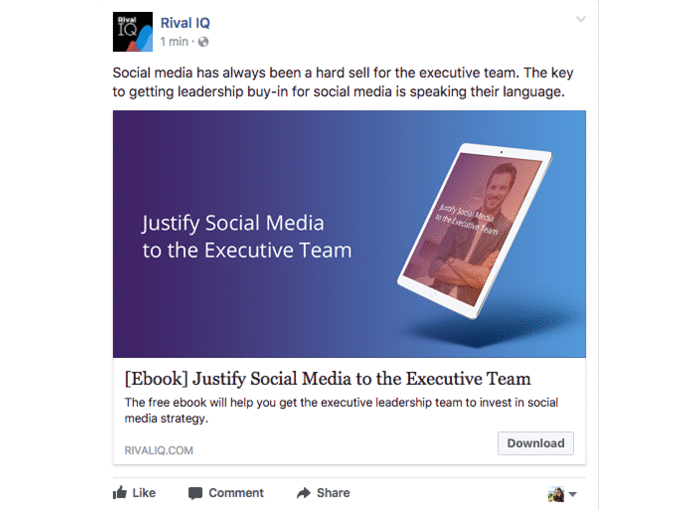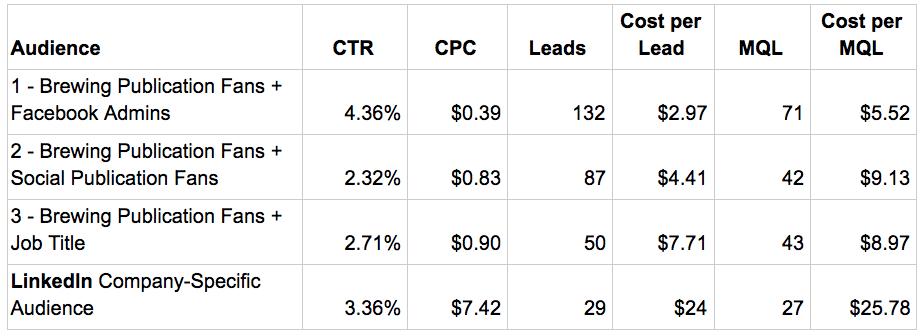Facebook can be one of the most daunting paid platforms for B2B brands.
Facebook doesn’t have that natural ‘fit’ that, say, LinkedIn or Adwords have when you’re targeting people in a business capacity. But it’s time to stop thinking like that. When you’re a B2B brand, you’re not actually selling to business: you’re selling to humans.
Go where your audience is
When I’m drafting channel strategy for a campaign, my first thought is: Where do my ideal customers spend their time online? For almost everyone under 65, that answer is going to include Facebook. There’s a misconception amongst B2B marketers that Facebook is a place where people go for personal time, and that B2B marketing is, therefore, unwelcome on that platform.
I’d argue that Facebook isn’t a personal platform these days: it’s a media outlet in much the same way that the New York Times or the Washington Post are. In fact, more than 60% of US adults get their news from their Facebook Feed. So if your audience is there: why wouldn’t you be?
Start with your objective
When you’re creating a Facebook Ads campaign, the first thing you’ll need to do is set your objective. Facebook’s platform has evolved to feature ten different ‘objective’ options, from video views to in-store visits. For B2B brands, the two most relevant objectives are Conversions and Lead Generation.
Conversions
Conversions are measured by installing the Facebook pixel on your website or landing page. The pixels allow for you to track when a lead has completed the action you’ve specified (such as downloaded content, registered for a webinar or signed up for a trial).
Lead Generation
The ‘lead generation’ objective is somewhat more complex. It’s a relatively new feature from Facebook and was developed with B2B advertisers in mind. A lead generation ad will look exactly the same to the user, except that when they click the call-to-action (sign up, learn more, download, etc.), a form appears right within Facebook’s interface. The in-platform experience is designed to lower barriers to completion by keeping people on Facebook’s website rather than sending them off-page (ie., to a landing page).
There’s another benefit to these forms: Facebook already knows most of the salient details about its users. It uses these details (Name, email, phone number, location, job title, company and so on) to auto-fill the form, further lowering the barrier to completion. Sounds pretty great, right? It is. In all of my tests, lead generation campaigns have outperformed conversions campaigns by an average of 20% based on cost per result.
However, there is one caveat: you’ll need a little technical wizardry to run a lead generation campaign. As of now, Facebook hasn’t added the ability for advertisers to deliver content after a user completes a form. An example of this would be an ebook download campaign (see .gif example below). Once a user completes the form, Facebook has no way of delivering the ebook to them.

If you have HubSpot, you’re in luck. HubSpot’s brilliant new Ads feature connects natively to Facebook and will instantly import the lead into your system. From there, you can set up a workflow that triggers when a form is completed and sends the ebook via email immediately. HubSpot will also directly attribute ROI right down to the individual ad.
If you’re not using HubSpot, don’t worry. There’s always a Zap for that. Zapier has ready-made zaps that will help you get leads directly into your CRM or marketing automation system, or send emails to leads.
Should I trust Facebook’s algorithm?
While we’re on the topic of objectives, it’s important to note that Facebook’s algorithm is key to helping you achieve them. But I wanted to test exactly how effective the algorithm is, so I devised a little experiment.
The Experiment
I ran two campaigns with the same audience, and the same ads, but assigned different objectives. I gave one campaign a ‘Traffic’ objective and the other a ‘Conversions’ objective, even though my real goal was to generate traffic. I believed that Facebook would display the ad to users it knows to be prolific clickers. On the other hand, I expected the conversion’s campaign to have a higher cost per click and lower click-through rate because Facebook would optimize delivery for higher-value conversions. So, I hypothesized that the traffic campaign would have a higher click-through rate and lower cost per click.
The Results
As usual, Facebook turned my hypothesis on its head. These were the results:

This experiment dissolved any doubts I ever had about the magic the Facebook algorithm weaves behinds the scenes of my conversions campaigns. But it also highlighted the fact that you should test everything. After all, my objective was to generate traffic, but the conversions campaign was far more successful than the traffic campaign.
Audience is everything
When I launch a new campaign, I’ll usually run it across multiple channels. The two biggest channels being LinkedIn Sponsored Content and Facebook Ads. I’ve seen success with both channels, but it really depends on the audience you’re targeting.
Let’s use my recent craft beer campaign as an example.
Rival IQ’s social analytics platform is already helping loads of craft brewers to improve their social engagement, so I developed an industry report that examined the social media success of the top 20 craft beer companies in the US. The campaign objective was to get other marketers in the craft beer industry to download this report, see how they’re doing relative to their peers and learn some great techniques to use in their social media campaigns. Once someone downloads the report, we have further activities in place to encourage trial sign-ups and move them further down the funnel.I chose to run ads for this campaign on both LinkedIn and Facebook for a number of reasons:
- LinkedIn allows the targeting of people at specific companies, with specific job titles. Facebook also allows this, in theory, but if a business has fewer than 5,000 employees I’ve often struggled to get Facebook to target them. With this campaign, I managed to get LinkedIn to target employees of every company in the top 50 list of the craft brewers association. However, on Facebook, I could only get it to target employees of massive brewers such as MillerCoors.
- In my anecdotal experience, LinkedIn leads tend to cost significantly more than Facebook leads, sometimes up to six times as much. However, I trust the veracity of LinkedIn’s first-hand data much more than Facebook’s third-party data. I’ve often had Facebook leads appear in our CRM and been unsure of how they possibly got through my stringent targeting.
Given these two points, you might be wondering why I would run ads on Facebook. The answer is that Facebook leads can be plentiful, cheap and high-quality if you can get the targeting right. It just requires a little creative thinking. Because Facebook doesn’t list ‘Craft Beer’ or even ‘Alcoholic Beverages’ as a B2B industry, and I couldn’t target employees of the top 50 craft breweries, I had to think hard about how I could identify people who work in the marketing or management function within this rather small vertical.
I did a little research on the industry and decided to target people who are Facebook Fans of particular beer-industry publications such as The Brewers Association, CraftBeer.com or BeerAdvocate. But being a fan of these pages wasn’t enough. I designed three audiences to branch off from this initial interest.
- Fans of brewing publications who are also Facebook Page Admins in the United States (this tells me that they are involved in social media in some way, shape or form). I’d call this a loose target.
- Fans of brewing publications who are also fans of Social Media Today or Social Media Week, in the United States. I guessed that people who are fans of both of these things had a good chance of working in social media in the brewing industry.
- Fans of brewing publications with our ideal social media/marketing job titles in the United States. This segment is an even tighter audience, targeting people with a specific set of job titles.
When you’re testing different audiences, I recommend using different ad sets within one campaign but using identical ads within them. Otherwise, you’re not truly comparing apples to apples.
Let’s take a look at the results of this audience targeting:

At first glance, you’d think that I would be smart to turn off Audience 3 – it’s doing worse by almost every metric. Its performance isn’t surprising – in my experience, the more tightly honed the audience, the more expensive the leads.
But let’s add some new data:

Here’s what this data tells me:
- While Audience 3 may be more expensive at first glance, the cost per MQL is lower than Audience 2. This audience is more aligned with our internal lead scoring, and thus more leads are making it through to sales.
- Audience 1 is getting me some very, very inexpensive leads. But only around half of them are meeting the lead scoring criteria to become MQLs. Ultimately though, it’s the most effective ad set.
- LinkedIn is damn expensive (I’ve never seen a click cost less than $6): but look at the Lead to MQL rate. Only two leads failed to hit our MQL threshold. Qualitatively, I can tell you that these leads tend to be more qualified with higher purchase intent than our cheaper Facebook leads. For this reason, I’m willing to pay the premium as long as it’s balanced out by the cheaper Facebook leads.
- That LinkedIn CTR is off the charts. For reference, the benchmark CTR on LinkedIn campaigns sits around 0.3%
Where to from here?
When you’re starting out with your first B2B Facebook Ads campaign, the first things to test are audience and objective. But there are myriad other levers to push and pull in your quest to obtain the most cost-effective, high-quality leads.
I like to test at least four different ads within each ad set (Two variations on image and two variations on call-to-action) as well as things like the optimal number of form fields or network and device placement (Facebook/Instagram/Audience Network/Mobile/Desktop etc.).
The best advice I have is to start with only a couple of tests at a time. You don’t want to become overwhelmed with too many data points at one time. Aim to learn one thing each time, then apply that learning to your next campaign. Keep testing, keep improving and remember the need to balance quantity with quality.
